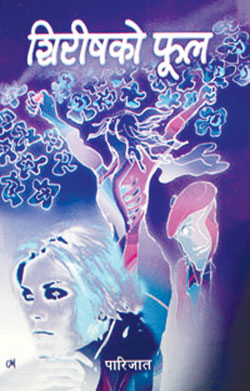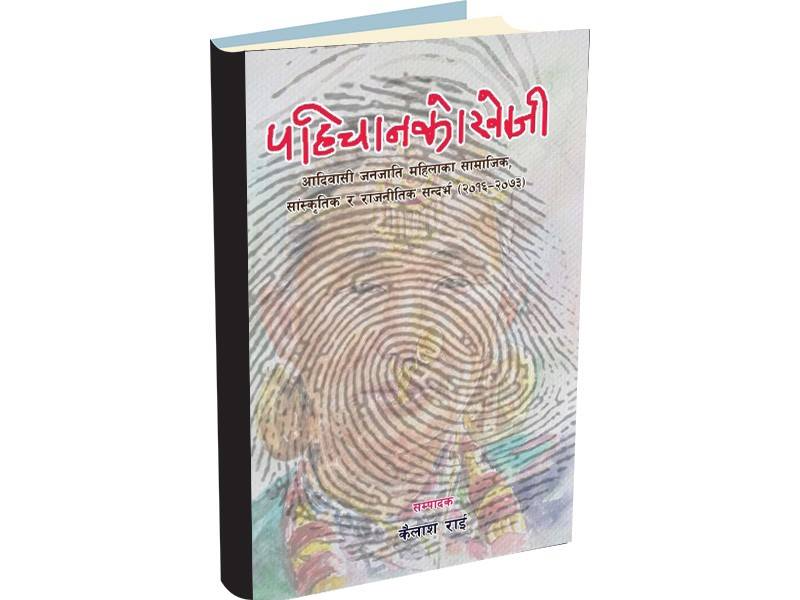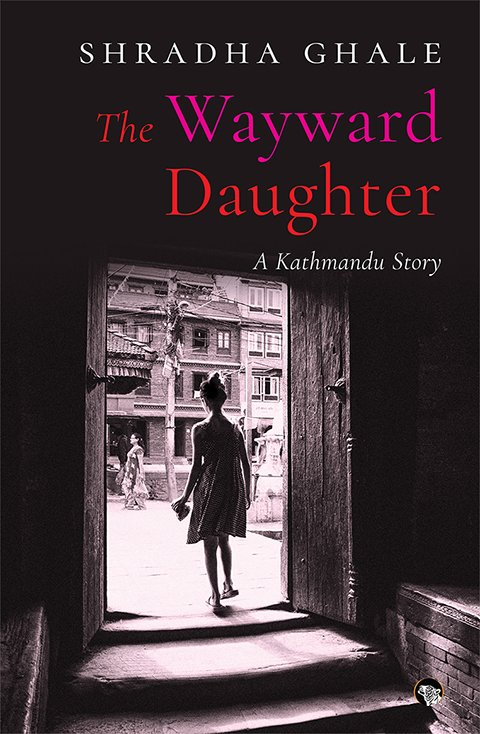On International Women’s Day 2019 (#IWD2019) Kripa Basnyat (Atlantic Fellow, LSE) contacted young feminists in Nepal to ask them what would make it onto their list of must-read books for those seeking a deeper understanding of the lives of women of Nepal. Below she explains what they chose and what their books – and two chosen by Kripa – show about the realities of women and their journeys in Nepal.
The books below are written in both Nepali and English and all share the same characteristic: they are some of the rare feminist books to have been published in Nepal. The stories of many Nepalese women from the country’s many different movements are still desperately needed and the narratives of women, told from a feminist perspective, remain absent. Today on International Women’s Day we must remember the urgency with which this should be corrected.

 Neelam Karki Niharika Yogmaya Sangri-La Books 2018
Neelam Karki Niharika Yogmaya Sangri-La Books 2018
Amuda Mishra, Founder of the Ujyalo Foundation picked Yogmaya written by Neelam Karki Niharika (winner of the Madan Puraskar Prize 2018). According to Amuda the book is a must-read to understand the inception of the women’s rights movement in Nepal. The book captures the journey of an ascetic and activist Yogmaya who challenged the autocratic Rana regime, which did not allow widows to marry, by remarrying twice. She therefore played a pivotal role in abolishing Sati Pratha (the act of self-immolation on the funeral pyre of a husband) in 1920. As her protest in opposition of the oppressive policies against women and their rights of the Rana regime, she along with her 67 disciples committed mass suicide by jumping into the Arun river in 1941. Amuda also said that despite being unheard of for many decades, Yogmaya is the icon of freedom for today’s generation of women who are trying to go beyond confined boundaries of gender to reclaim their space in society, and explore their unique self without the fear of social stigma and discrimination.
Parijat Shiris Ko Phool 1965
 Alina Saba, a young feminist and activist, thinks that Sirishko Phool, written by Nepal’s most beloved writer Parijat (Bishnu Kumari Waiba), is one of the most critically acclaimed, widely read and reviewed books in Nepali literature. Even though the novel, published in 1965, is set after the Second World War it strong female protagonist Sakambari who questions ideas of masculinity means the book is way ahead of its time. The main character Suyog Bir Singh is forty-five-year-old and a former World War Two soldier. The book’s narrator is an alcoholic who lives a lonely life in which his unrequited love for 26-year-old Sakambari causes him unbearable pain – compounded by the fact he feels unable to express such feelings.
Alina Saba, a young feminist and activist, thinks that Sirishko Phool, written by Nepal’s most beloved writer Parijat (Bishnu Kumari Waiba), is one of the most critically acclaimed, widely read and reviewed books in Nepali literature. Even though the novel, published in 1965, is set after the Second World War it strong female protagonist Sakambari who questions ideas of masculinity means the book is way ahead of its time. The main character Suyog Bir Singh is forty-five-year-old and a former World War Two soldier. The book’s narrator is an alcoholic who lives a lonely life in which his unrequited love for 26-year-old Sakambari causes him unbearable pain – compounded by the fact he feels unable to express such feelings.
Parijat beautifully presents the constant battle between his emotions towards Sakambari, his lonely life and his inability to express his feelings – a result of his masculinity in which vulnerability and an inability to talk about emotions openly is a sign of weakness for a Second World War soldier.
One thing that has struck Alina most is that the writer interestingly mentions Sakambari’s short haircut and chain smoking habit, signs she takes of a ‘modern women’. When most women in 1965 were required to keep their hair long, not allowed to drink, smoke and had to listen to what the male members of family had to say.
In 2019 many of these cultural aspects of the novel remain the same, but much has changed. Alina remarked that in the last 50 years, the number of women who can have short hair has increased, but smoking in public and discusses politics are still male-dominated activities. While world wars may be a thing of the past, young Nepali man under the Gurkha Regiment still fight. Women are still told to be well-behaved and softly spoken; delivering justice to a rape or sexual abuse victim remains a battle.
Kailash Rai Pahichanko Khoji: Aadibasi Janjati Mahilaka Samajik, Samskriti ra Rajnaitik Sandarva (v.s.2016 to 2073) [In Search of Identity: Socio-cultural and Political Context of Indigenous Women (1960-2016)]

Kailash Rai’s Pahichanko Khoji: Aadibasi Janjati Mahilaka Samajik, Samskriti ra Rajnaitik Sandarva (In Search of Identity: Socio-cultural and Political Context of Indigenous Women), published by Indigenous Media Foundation in 2016, is a collection of articles related to the socio-economic and political status of indigenous women not only within their own community but also in a broader national human rights community in Nepal. It covered the six decade long historical and socio-cultural-political context of Indigenous women. (A review of the book was published in Martin Chautari’s journal ‘Samaj Adhyayan 12’ in 2017.) Within the book there are narratives that tell the stories of damaging forms of social reproduction. The book cleverly points out the gaze towards indigenous women and how they are looked at by men in contrast to the dominant group of women in Nepal. Adivasi indigenous women’s openness and lack of inhibition in comparison to women from these dominant groups are misconstrued to be immoral and evidence of criticised behaviour. This book is useful for understanding the indigenous women’s movement and where it is placed against mainstream politics. The book also explores the issues of identity and sexuality from an intersectional perspective.
Shradha Ghale The Wayward Daughter: A Kathmandu Story Speaking Tiger 2018
 Delhi-based publisher Speaking Tiger writes that The Wayward Daughter is “the story of a young girl seeking out love, finding herself and her own spaces in life. Equally, it draws a telling portrait of Kathmandu—its class and caste divisions, its cosmopolitanism which exists alongside conservative attitudes, and its politics due to which a civil war looms”. Written with humour, empathy and skill, this novel is a must-read and picked by Rina Burathoki, a university student and young feminist. Rina believes that The Wayward Daughter is an interesting read because it is based in the 1990s which is the time she grew up in Kathmandu and was studying in school. She and her brothers were the first generations in her family to go to a private boarding school and study in English, therefore the protagonist Sumnima’s insecurity and doubts presented in the book were very much relatable to her. She feels it is an important piece of writing because it is a story of a young school going girl from a middle-class indigenous community. There are fewer stories written from that lens which someone like her and the writer herself can relate to. The stories of Sumnima’s friends in her school shows what the education institutions were doing at that time and what were they catering to was definitely not educated empowered women, but rather to make presentable homemakers. There are many underlying stories which are important to understand the women’s movement in Nepal because the 1900s was the time when non-government organisations started to boom in Kathmandu.
Delhi-based publisher Speaking Tiger writes that The Wayward Daughter is “the story of a young girl seeking out love, finding herself and her own spaces in life. Equally, it draws a telling portrait of Kathmandu—its class and caste divisions, its cosmopolitanism which exists alongside conservative attitudes, and its politics due to which a civil war looms”. Written with humour, empathy and skill, this novel is a must-read and picked by Rina Burathoki, a university student and young feminist. Rina believes that The Wayward Daughter is an interesting read because it is based in the 1990s which is the time she grew up in Kathmandu and was studying in school. She and her brothers were the first generations in her family to go to a private boarding school and study in English, therefore the protagonist Sumnima’s insecurity and doubts presented in the book were very much relatable to her. She feels it is an important piece of writing because it is a story of a young school going girl from a middle-class indigenous community. There are fewer stories written from that lens which someone like her and the writer herself can relate to. The stories of Sumnima’s friends in her school shows what the education institutions were doing at that time and what were they catering to was definitely not educated empowered women, but rather to make presentable homemakers. There are many underlying stories which are important to understand the women’s movement in Nepal because the 1900s was the time when non-government organisations started to boom in Kathmandu.
 Nepali Migrant Women: Resistance and Survival in America illustrates the change in narrative of women migrating to a foreign land for domestic care work who send remittances to their families, along with supporting international charitable organisations. The book raises stories of how women are defying the stereotypes and re-negotiating gendered expectations, roles and responsibilities. In this book a female migrant’s agency and leadership is exercised through local and transnational nongovernmental organisations and supporting the marginalised communities back in Nepal. The book questions what structural and personal factors compel educated women to migrate to the United States for work; what kind of relationships they experience; and how Nepali women’s involvement in the public sphere through paid work and transnational activities destabilise and reinforce gendered relations in Nepali families. This is an important work to be added to the literature on gender, globalisation, transnationalism and care work.
Nepali Migrant Women: Resistance and Survival in America illustrates the change in narrative of women migrating to a foreign land for domestic care work who send remittances to their families, along with supporting international charitable organisations. The book raises stories of how women are defying the stereotypes and re-negotiating gendered expectations, roles and responsibilities. In this book a female migrant’s agency and leadership is exercised through local and transnational nongovernmental organisations and supporting the marginalised communities back in Nepal. The book questions what structural and personal factors compel educated women to migrate to the United States for work; what kind of relationships they experience; and how Nepali women’s involvement in the public sphere through paid work and transnational activities destabilise and reinforce gendered relations in Nepali families. This is an important work to be added to the literature on gender, globalisation, transnationalism and care work.
This article gives the views of the author, and not the position of the South Asia @ LSE blog, nor of the London School of Economics. Please read our comments policy before posting. Photo credit: Pixabay – BenediktGeyer
Kripa Basnyat is an Atlantic Fellow for Social and Economic Equity at the International Inequalities Institute, London School of Economics.







